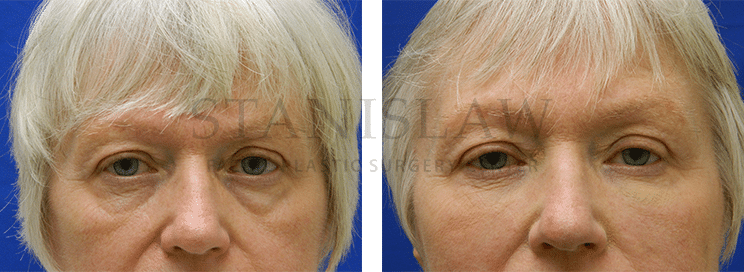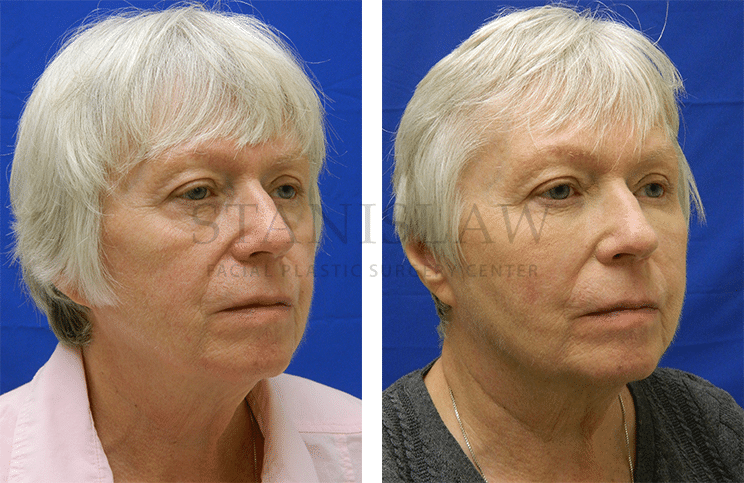What are Malar Bags?
Malar bags or malar mounds are the bumps that occur just below the outside corner of the eye, on the top of the cheekbone. Malar bags do not form from tissue growth or from something raising up the tissue in that location. Malar bags are relative elevations in that they only appear like a bulge because the cheek below is sinking. An analogy is that of a rock at the beach. When the tide is high, the rock looks small. As the tide goes out, the rock looks bigger. The malar bag is the rock, and as we get older, the tide goes out with the loss of fat and bone from the cheek directly below the bulge. This creates the appearance of a malar mound. Usually, at the bottom of the malar bag is a sharp crease that runs diagonally from the inside corner of the eye down laterally. Malar bags occur equally in both men and women, becoming more pronounced as we age.
Malar bags are different from festoons. Festoons have the appearance of a “swag” in the skin on the cheek directly below the eye. Festoons and malar are caused by thinning skin of the lower eyelid and skeletonization of the orbicularis oculi muscle (the muscle that wraps around the eye and closes the eyelid). Festoon treatment will improve appearance when the patient squints and tightens up the muscles around the eye. Malar bags do not improve with squinting and tightening the orbicularis oculi muscle.
HOW DO YOU TREAT MALAR BAGS?
The best treatment for malar bags is the injection of fillers such as Restylane, Juvederm, or Voluma into the cheek below the malar bag to hide the shadows of the cheeks and to restore the gentle convexities of youthful cheeks. If there is a very sharp, embedded malar crease, the filler needs to be injected directly below the crease and into the skin of the crease to change the concavity to a gentle convexity. Following the injection, you may have some bruising, but this is much less common since we use cannulas (blunt-tipped needles that are less likely to cause a bruise). We often prescribe medication to take before and after the injection to decrease the amount of swelling that can occur after an injection. For the first twenty-four hours after the malar bags treatment, you should apply ice to your cheeks and limit your bending amount. You can shower and wash your face that day, and you can resume the use of makeup in the area the next day. You will follow up with Dr. Stanislaw seven to ten days after the injection when the injectable filler can still be molded and sculpted if needed.
Also, if you use retinol or Retin-A, you should stop using these creams in the areas to be injected one week before the injection and for one week after the injection.
Depending on the causes of the malar bag, a facelift can sometimes help improve the appearance of malar eye bags themselves. A facelift can free the malar crease skin from the ligaments anchoring the skin to the bone, allowing the skin and the fat to be repositioned to help create a better contour of the cheek and, therefore, hide the malar bags. At the same time, a facelift will restore a youthful appearance by removing excess skin and tightening areas of significant skin laxity.
WHAT CAUSES MALAR BAGS?
The etiology of malar bags is multifactorial. Even in one person, there can be several different components or factors causing the appearance of a malar bag. The malar mound can be caused by the formation of a malar crease at the lower border of the malar bag. The following are possible causes of malar bags:
- The loss of cheek fat in the area below the eye causes a hollowing of the cheek, which can make the malar bag look more pronounced. The loss of cheek fat can be age-related, but it can also be seen in people in good physical shape with very little body fat.
- An osteocutaneous ligament attaches the skin to the underlying bone of the lower eyelids. Think of it as an anchor that keeps your skin from sliding off your cheekbone. As we age, our facial bones resorb and change shape. The facial bones essentially involute in all directions: front to back, up and down, and side to side. The osteocutaneous ligaments pull the skin in as the bone sinks inwards, causing the crease.
- The crease below the malar bag can be an actual embedded crease in the skin. The skin has taken on a cupped shape. If you look very closely at the crease below the malar bag, you will see a lot of enlarged pores. If you look at the skin of lower eyelid bags, there are no pores, and the skin is smooth. These pores in this crease cause inflammation in the deep layers of the skin. This inflammation in the deep layers of the skin causes a differential in skin growth between the top and bottom layers. This differential in growth is similar to a plant bending towards the light. The side of the plant exposed to the light grows slower than the side not exposed to the light. This differential in growth causes the plant to bend towards the light (essentially causing an arch in the plant stalk). This differential in skin growth causes the trough in the skin.
- The osteocutaneous ligament anchors the cheek skin to the underlying bone. When you smile, you will notice that the cheek bulges up to the point of the malar crease, but because it is securely anchored to the bone, the bulge stops right at the crease. From years of smiling, the fold has become embedded in your cheek.
- In rare instances, people can have swelling of the malar bag from fluid retention. In this situation, instead of gravity draining the fluid out of the malar bag, the fluid gets trapped above the malar crease and causes the malar bag to become more prominent.






 REVIEWS
REVIEWS